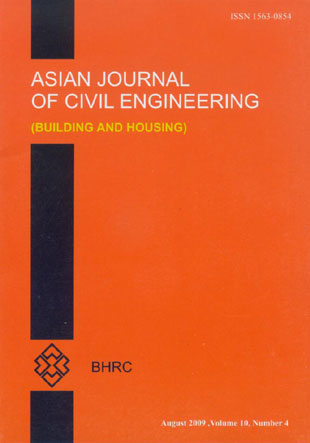فهرست مطالب

Asian journal of civil engineering
Volume:10 Issue: 4, Aug 2009
- تاریخ انتشار: 1388/07/11
- تعداد عناوین: 7
-
-
Page 381In this paper, an energy formulation of the force method is developed and the analysis,design and optimization are performed simultaneously using ant colony algorithms. Newgoal functions are introduced for minimization, and ant colony algorithms are employed forcontinuous optimization. An efficient method is introduced using ant colony algorithms fordesigning structures with prescribed member stress ratios. Finally, minimum weight designof truss and frame structures is formulated using ant colony algorithms and applied to some benchmark problems from literature.
-
Page 397This study investigates a time-domain method for modeling general transient elastodynamic problems using the spectral-based finite element method (SEM) which is based upon a conforming mesh of two-dimensional quadrilaterals. Employing the Galerkin weighted residual method, detailed formulation of the SEM is derived in which various aspects involving in elastodynamic problems are discussed. The accuracy and efficiency of the method is fully demonstrated by comparing results obtained from the SEM with thosereported in other studies. For this purpose, a set of wave propagation and structural dynamic problems, subjected to various load forms such as triangular load, Heaviside step load, sinusoidal impulsive load, and ramped load are modeled using the SEM. Furthermore,support motion boundary conditions are examined using the SEM. Each problem issuccessfully modeled using a very small number of degrees of freedom in comparison withother numerical methods. The numerical results agree very well with the analytical solutions as well the results from other numerical methods.
-
Page 409This paper attempts to calculate column shortening and differential shortening betweencolumns and walls in concrete frames using a nonlinear staged construction analysis basedon the Dirichlet series and direct integration methods. Prototype frame structures areidealized as two-dimensional and the finite element method (FEM) is used to calculate thecreep and shrinkage strains. It is verified with respect to published experimental andanalytical results. B3 model and methods such as AAEM, EMM, IDM, and RCM are usedfor verification purposes.For each frame, effects of creep and shrinkage parameters such as relative humiditypercent, rate of construction, shrinkage parameter, and concrete strength have been takeninto consideration separately. The manner in which creep and shrinkage can influence the behavior of concrete structures also has been discussed.
-
Page 427In this two-part paper, the response of restrained SIFCON two-way slabs is investigated. In part-1, different restrained SIFCON two-way slab specimens were loaded in flexure using the Whiffle-Tree loading arrangement and first crack loads, ultimate loads and loaddeflection responses were obtained. In part-2 results from punching shear tests performed on SIFCON two-way slabs are reported. Black steel wire fibres were used in the production of SIFCON slab specimens and the influence of fibre volume percentage on flexural and punching shear behavior is investigated.In this paper, the influence of volume percentage of steel fibres on strength and stiffnesscharacteristics of slurry infiltrated fibrous concrete (SIFCON) slabs is investigated bytesting nine numbers of SIFCON slabs under flexural loading. In order to compare theresults, three numbers of fibre reinforced concrete (FRC) slabs and three numbers of plaincement concrete (PCC) slabs are taken as control specimens. The test results indicate that the SIFCON slabs exhibit high strength, high energy absorption and more ductilitycharacteristics compared to the control specimens. SIFCON slabs with higher fibre volumefraction(12%fibre volume) exhibit superior performance among other slab specimens.Analysing the crack patterns noticed in the experimentation, yield line analysis has beenperformed and the bending moment coefficients for SIFCON slabs are calculated.
-
Page 451A finite element model based on the layerwise theory of Reddy is developed for the analysis of delamination in the [90/0]S cross-ply laminated beams. The Heaviside step function was adopted in the formulation to express the discontinuous interlaminar displacement fields of delaminated layers. Also, to accommodate the moderately large rotations of the beam, the von Kármán type nonlinear strain field is used in the formulation. The finite element model is verified by comparing the present solutions with those available in the literature. It is shown that the present finite element model is able to capture accurate local stress fields and the strain energy release rates. Then the model is used to study delaminated cross-ply laminates under bending loads. The influence of boundary conditions and number of layers on the strain energy release rates is studied. Also, the growth of delamination is investigated for a pure bending case, and the mode of delamination growth is identified. The influence of geometric nonlinearity on the delamination growth is also investigated as the delamination advances. It is found that geometric nonlinearity does not significantly alter the delamination kinematics and strain energy release rates.
-
Page 481In part 1 of this paper, flexural tests conducted on restrained SIFCON two way slabs weredescribed and the load-deflection responses under flexural loading were reported. Threedifferent types of slabs i.e. SIFCON slabs, FRC slabs and PCC slabs were investigated. Itwas found that flexural performance of SIFCON slabs is quite superior when compared toFRC and PCC slabs. Among SIFCON slabs those containing twelve percent fibres byvolume exhibited excellent load carrying capacities, ductility and energy absorptioncapacities.In part 2 of the paper, the effect of various volume percentage of steel fibre in SIFCONslab specimens subjected to punching shear was studied. The punching shear load wasapplied to simulate a column-footing connection. From experimentation, the failure loads,deflection and crack patterns in punching shear were studied. Fibre reinforced concrete(FRC) and plain cement concrete (PCC) slab specimens were used as control specimens.The results reported that SIFCON slabs with 12% fibre volume possess high performancethan the other slab specimens in all respects. The experimental results are compared withthe ACI and IS codes and the need for separate provisions for SIFCON in punching shear isemphasised. A regression model has been developed to predict the punching shear capacity of SIFCON slabs.


